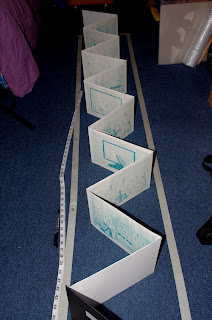Pictures and Words, by Roanne Bell and Mark Sinclair
An interesting book which includes multiple styles of illustration, I have been using this for narrative research for FMP. This is where I found Andrjez Klimowski's The Dream Depository, which appealed to me due to the wordless narrative. (below).

Fredrik von Blixen's Lost and Found
In this work I really like the intricate style of illustration used within this narrative, since I find this akin to my work. I also like the minimal line of text below the illustrations, which allows the reader to focus largely on the imagery. The text is dreamlike and a little disconnected from the imagery, but reads like a poem with the added dimension of the images. The combination of text and image does not necessarily allude to a strict answer or interpretation, and the viewer is left to consider their personal interpretation.
Lost the second part, and
Found the final in a trilogy that still requires a first instalment. It's interesting how the parts have been released in this order, I feel it creates an impressionistic air about the work since one would have to rely upon their own assumptions regarding the story.

"It began as an intention to conclude what my notion of 'lost' is" says von Blixen. "However, I'm still looking for it and the moral of the story changes every time... I suppose I lost my head and found a box of 'ifs' and 'ors' that will never stop bothering me".

In Silence by Anna Bhushan
This image is taken from the book We Lie Together which was written in collaboration between Bhushan and fellow Royal College of Art graduate Laura Carlin. The project was to create a book within a book, which upon first reading shows an idyllic domestic environment through Carlin's images with words enhancing this. The book is French-folded, so after reading through the reader can tear open the pages along the folds to reveal Bhushan's images, which completely invert the meaning of the story. The second set of images are silent, like the panel left, and create a heavily emotive narrative. I like the very flat and linear two dimensional style of illustration; it reminds me of my own prints.
 Martin tom Dieck: La FM and Untitled
Martin tom Dieck: La FM and Untitled
Left is the silent third part of La FM, which has been left as an enigma by the author. The colour scheme of this work really appeals to me, and I appreciate the combination of painting and drawing. Despite probably being unrelated in context and style it reminds me of The Depository, as it begins with a man sat by his desk who seems to be stuck on something. The contrast of the colours work really well together, and it's interesting to see that only a limited colour palette of red/black/yellow has been used. Through this Dieck creates a very striking narrative.

This story was left un-named in the book, and was originally published in Die Zeit magazine. The dreamlike nature of the story can be attributed to the content of the sequence, which was "built around the moment between sleeping and waking and the attempt to make this moment last". Again his work reminds me of Klimowski's work, but this time it is due to the contrasting black and white of the frames. Dieck uses minimal text to express whimsical thoughts of the character, for instance in the fourth panel "Alas, those old songs," and seventh "What, however, do we know under water?" In the story the main character is shown to be gathering all of his smaller "selves" from his floor, whilst in a hypnogogic state.














.jpg)


.jpg)
































